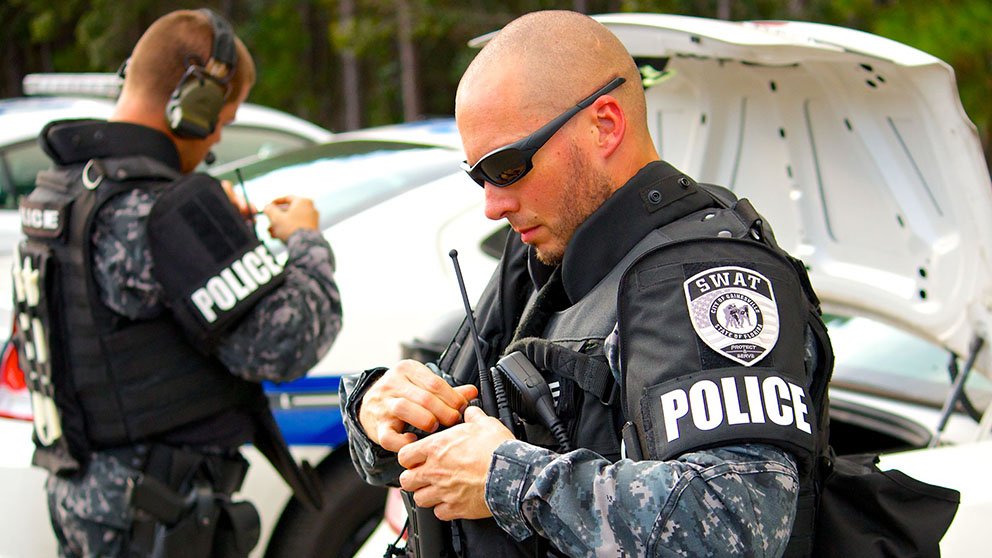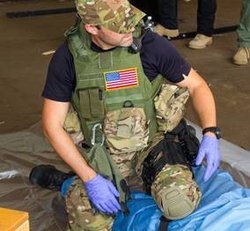
On a quiet Saturday morning in October 2018, University of Pittsburgh emergency physician Keith Murray, MD, was helping his 3-year-old son get ready for a birthday party when the alert came on his phone.
Active shooter. The Tree of Life synagogue.
Within minutes, Murray was on his way to the scene. Donning body armor and helmet, he located other members of his SWAT team and approached the synagogue near downtown Pittsburgh. The 45-member unit divided into groups, entering the building at two separate locations.
Inside: unspeakable carnage. Eleven dead. Many wounded. And the shooter was still somewhere in the building. When Murray’s contingent finally found him, automatic gunfire erupted. One officer was hit at least seven times.
“Within 45 seconds, we had the full tactical EMS team working on him,” Murray remembers. “We cut away his clothes, put five separate tourniquets on him, assessed his injuries.”
Although gravely wounded, the officer is alive today and recovering, says Murray, thanks in large part to the almost instantaneous response.
“Within 45 seconds, we had the full tactical EMS team working on him. We cut away his clothes, put five separate tourniquets on him, assessed his injuries.”
Keith Murray, MD
University of Pittsburgh
Murray is one of a select but growing group of physicians around the country who serve as members of SWAT teams and other special operations units. Experts in trauma medicine, triage, and mass casualty care, they’re also rigorously trained in the tactics of high-risk law enforcement operations — a hybrid practice so new there is as of yet no agreed-upon name for it.
Variously called tactical EMS, special operations medicine, and law enforcement medicine, this work is often described by the people who do it simply as “the best medicine in the worst places.”
Responding to a changing threat
Law enforcement medicine — the term many experts prefer — has its roots in military medicine. “One of the invaluable lessons we’ve learned from the military over the past two decades is that the earlier we can render trauma care to critically injured people, the better their chances of survival,” says Matthew Levy, DO, associate professor of medicine and senior medical officer at Johns Hopkins Center for Law Enforcement Medicine. For example, one study of casualties in Iraq and Afghanistan found that immediate trauma care might have prevented almost one-quarter of the battlefield deaths.

With the proliferation of military-style assault weapons among civilians and recent horrific shootings in Orlando, Las Vegas, and elsewhere, mass violence has increasingly become a fact of life in the United States.
"Whether we’re talking automatic weapons, explosives, or terrorist attacks, law enforcement has to be ready to address those threats,” says Levy, who was a first responder during the 9/11 terrorist attacks and still works with several regional and federal tactical units. “When the SWAT team is called in, they are really the last resort. The SWAT team can’t call 911. So having tactically trained medics and physicians as part of special operations teams makes every member of those teams safer. That’s a key component of what law enforcement medicine is all about.”
“[H]aving tactically trained medics and physicians as part of special operations teams makes every member of those teams safer.”
Matthew Levy, DO
Johns Hopkins Center for Law Enforcement Medicine
Preparing for the frontlines
A physician trained in emergency medicine already has the basic medical knowledge needed for law enforcement medicine.
“We’re not performing surgery on the side of the road, the way you might in a military setting,” says John Slish, MD, a clinical assistant professor of emergency medicine at the University of Florida College of Medicine who serves with the Gainesville Police Department SWAT team. “We’re stopping the bleeding, doing airway management, getting someone stabilized so they can be transported to a trauma center.”
What sets SWAT doctors apart is their intensive training in law enforcement and special operations procedures and tactics. “You need to understand the chain of command,” says Slish. “You need to know exactly what to take with you, what’s portable. You need to know how not to disrupt what’s potentially a crime scene. In some cases you may need to know how to work as quietly as possible, so the bad guy doesn’t know you’re there. Along with the potential for bullets traveling through the air, there are meth labs, hazardous materials, all kinds of risks.”

Currently, no accredited law enforcement medicine subspecialty exists. But in recent years, a growing number of academic medicine institutions have begun offering tactical EMS components in emergency medicine programs, typically through affiliations with local law enforcement agencies.
For over a decade, Johns Hopkins Medicine’s Center for Law Enforcement Medicine has offered a two-year fellowship in tactical medicine, which is open to physicians who have completed their emergency medicine residency. The program includes training in law enforcement principles and procedures, caring for the wounded during high-threat situations, and hands-on training with local, state, or federal law enforcement agencies.
“By the end of the program, our physicians have deployed with law enforcement teams and provided operational medical support to high-risk law enforcement operations,” notes Levy. “They also have hands-on experience in the planning of medical support tactics for mass gatherings with heightened security and other high-risk operations.”
Tubes, ropes, and firearms
There is no single career path for physicians who serve with SWAT teams — although some start out in the military — and law enforcement agencies each have their own criteria for accepting candidates.
For most physicians, being a SWAT doctor isn’t a full-time job. Many have other positions, including in academic medicine, that enable them to donate their time to the team. In some cases, emergency medicine physicians at teaching hospitals devote a portion of their allotted department hours to working in law enforcement settings. And SWAT team physicians are sometimes paid as part of a broader position, such as an EMS medical director for a particular jurisdiction.
Once they’ve joined a SWAT team, physicians typically meet with the group once or twice a month to engage in exercises, including simulated medical emergencies in “tubes” (anything from a subway car to an airplane), rescues using ropes to extricate the injured from upper stories, responding to an active shooter in a public space, and more.
“You need to know how not to disrupt what’s potentially a crime scene. … [Y]ou may need to know how to work as quietly as possible, so the bad guy doesn’t know you’re there.”
John Slish, MD
University of Florida College of Medicine
Most SWAT physicians also have training in the safe operation of firearms, and many carry weapons with them when deployed. When a physician isn’t armed, a SWAT officer is typically assigned specifically to protect the medical team. Some law enforcement agencies also send their physicians and medics through a police academy and then deputize them with law enforcement powers.
Asked if he’s ever afraid, Murray says he always feels confident going in, that the team is trained and ready. “But ask my wife if she worries,” he adds, “and you’d get a different answer.”
Caring for the team
Certainly, there’s an adrenaline rush to law enforcement medicine, but the working lives of SWAT doctors aren’t always the stuff of Hollywood thrillers.
“In many ways, law enforcement physicians are like doctors on professional sports teams,” says Levy. “The bulk of the work is really looking after your team members. These are highly trained and physically conditioned professionals, and the job is to keep them healthy so they are ready when they are called on. That requires a combination of emergency medicine, sports medicine, and occupational medicine.”
Murray’s team, for example, is made up mostly of men in their thirties and forties. “There’s hypertension, hyperlipidemia, sports injuries, you name it,” he says. Given that SWAT teams are like close-knit families, members are often more likely to turn to him than to their own physicians, he notes.
For most SWAT doctors, the work is a labor of love, say those involved, and they choose this potentially dangerous field in order to give back to their communities.
“We send these people out to protect us,” notes Slish. “They are our first responders. We put them in harm’s way. We owe them the best care we can offer.”